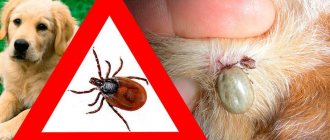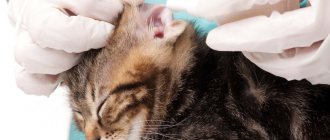Sometimes owners are faced with such an unpleasant problem as ticks on cats. What to do with them and how to get them out? These parasites live on the surface of the skin and in its outer layers.
These insects live in tall grass and move onto cats, most often during a walk. To remove them, you will need special tools, and it is also worth learning how to use them correctly. If a cat is bitten, it is necessary to take all necessary measures as much as possible.
Types of cat ticks
Cats typically suffer from three types of these parasites:
- ixodid and argasid;
- scabies;
- ear
The first type is characterized by small sizes, about 4 mm. The Argas type is large in size, usually from 3 to 30 mm. Both of these species have four legs. At the first stage of development, that is, in the form of a larva, they have 6 legs.
These parasites differ in the structure of their body. Ixodids have a flat body, tapering on one side. On the back there is a shield with a dark color. Argasaceae have a wide body, enlarging after eating. This is due to folds that can stretch significantly without damaging the outer shell of the tick.
After complete saturation, the tick falls off, leaving a red spot on the cat’s body with a burgundy dot in the center.
Ixodid ticks
This type of tick is a carrier of some dangerous diseases for animals, such as hemobartonellosis and tularemia, piroplasmosis.
Cats tolerate the latter disease much easier than dogs, but in the chronic stage it leads to complications in the future. Hemobartonellosis is an infectious disease that is asymptomatic in most cases. Less commonly it may appear as:
- lethargy of the animal;
- fatigue;
- poor appetite;
- disturbed breathing rhythm;
- temperature;
- heart rhythm disturbances;
- pallor of the mucous membranes of the eyes and gums.
Tularemia is a bacterial disease. Some time after the bite (1-10 days), the animal develops small sores in the mouth, tongue, head or neck. The animal's lymph nodes become enlarged, and in some cases the cat may begin to cough, as the disease affects the respiratory system. Sometimes this disease can even lead to the death of a pet. Tularemia can be transmitted from animals to humans.
Ear mite
This is one of the most common types of blood-sucking parasites, which affects both indoor and outdoor individuals. This is a small arthropod that breeds in warm, humid environments. After infection, the arthropod penetrates the ear canal, which leads to abundant production of sulfur and scabies. This usually occurs in both ears at the same time, causing pain and suffering to the animal. Ear mites can be recognized by a number of characteristic symptoms:
- the pet becomes restless;
- often shakes his head, meows pitifully;
- rubs ears against various surfaces, especially corners, scratches ears with paws;
- a purulent mass with a characteristic odor appears in the auditory canal;
- Dark brown crusts appear in the animal's ear.
If treatment is not started, the bloodsucker will penetrate the pet’s inner and middle ear and the meninges. This has more dangerous consequences, such as:
- depressed state of the cat;
- high temperature;
- the cat's head is strongly bent to the side;
- seizures;
- death of the animal.
To prevent this scenario from happening, at the first symptoms you need to seek the help of a veterinarian who will rid your cat of ear mites.
Scabies mite
Veterinarians divide scabies into three types, depending on the type of parasite:
- type of sarcoptic mange is carried by Sarcoptes canis;
- demodicosis – Demodex (cati or gatoi);
- notoedrosis – Notoedres.
Scabies can be of two types:
- Local or localized.
- General or generalized.
Scabies mites cause two types of disease in cats. In the first option, the tick settles on one part of the body, except for the animal’s paws. With the general form of scabies, the entire body of the animal is affected, including the limbs. The second form is more dangerous and more difficult to deal with.
If the pet has good health and immunity, the parasite is in “sleep mode”. The disease passes without any symptoms. If the cat's immunity weakens, the parasite will begin its activity.
What does an ixodid tick look like?
And before or after meals? After all, these are two big differences!
Externally, the tick is similar to a spider - an oval body with a small head and eight limbs. They are quite large, and females are much larger than males. The body is covered with a dense chitinous shell. In the female, the armored shield occupies only the front part of the body, allowing their digestive system and integument to stretch from several mm to one and a half cm, depending on saturation. Therefore, ticks can feed rarely (sometimes once in a lifetime), but a lot.
Their oral apparatus is equipped with a proboscis with a hypostium - on the elongated outgrowth there are sharp, posteriorly directed teeth - this is a device for piercing the skin and sucking blood. During a bite, saliva is injected into the wound, containing pain-relieving enzymes and hardening around the proboscis like cement. Thus, the tick is firmly attached to the host and can sit on it for a long time, from 3-4 days to a month. The longer a tick sits, the more difficult it is to remove it (remember the expression “clung like a tick”).
The sucked parasite increases in size, acquiring a spherical shape. A hungry tick can be dark brown, black or brown; after eating, it turns red, pink or gray. The satiated parasite falls off to rest for digestion, the female lays eggs and dies.
In their development, ixodid ticks go through the following phases: egg, larva (six-legged), nymph and, finally, adult - adult (eight-legged). Larvae and nymphs usually live on small mammals (rodents), while adults live on large domestic animals.
How to find a tick on a cat's body
Many owners, having suspected something wrong in their pet’s behavior, do not know how to detect a tick on the animal’s body. Distinctive features are: black, gray body, round or drop-shaped;
- the number of legs depends on the developmental phase (a young individual has 3 pairs, an adult – four);
- has a proboscis on its head through which the parasite feeds;
When sucking, the parasite goes deep into the skin with its head, and the body remains outside. It is difficult to detect ticks, especially in the animal’s thick fur. Judging by its size, you can understand how long it has been feeding. Before suction, it looks like a small seed, but after feeding, its size increases significantly, and its color changes to red, pink or burgundy.
In this state, it is much easier to find the parasite; for this you will need a good bright light and a fine-toothed comb. It is advisable to calm the animal and position it comfortably. Then take a comb and comb the entire surface of the animal and feel against the growth of the fur. To make the process easier, you need to trim the hair around the tick.
Signs and symptoms of bites
During the incubation period, the cat looks absolutely healthy. After this, the first signs of a bite begin to appear:
- change in urine color (red, dark, black, green);
- lethargic state;
- constant thirst;
- inactivity;
- loss of appetite;
- diarrhea and vomiting;
- anemia;
- high body temperature.
The temperature may be observed in the first days, after which it drops to a normal level. If the disease progresses, the cat's condition constantly worsens and new symptoms appear. If you are unable to cope with this problem on your own, you will have to contact a veterinary clinic for help from specialists.
Favorite places
Ticks are most easily found on parts of the body without fur. Their favorite places are:
- armpit area;
- groin area;
- the inside of an animal's ears.
In these areas, parasites are more common than usual.
Interesting read: How long can cats sleep?
Why is a tick bite dangerous for a cat?
A tick bite for a cat is dangerous due to the following developments:
- tularemia;
- hemobartonellosis;
- piroplasmosis;
- theileriosis;
- anemia (in case of massive tick infestation).
Cats and dogs have species-specific resistance to the causative agent of tick-borne encephalitis and do not get sick from it.
Tularemia
Tularemia is an infection that is dangerous for both cats and humans, as well as other domestic animals, including rodents and birds. This is a natural focal disease, the causative agent is the bacterium Francisella tularensis. Foci of tularemia are dispersed throughout our country.
Tularemia is highly contagious; 10–50 bacteria are enough for a person to develop the disease. Human infection is possible through airborne, nutritional and contact routes. Transmission of bacteria through intact skin and mucous membranes, as well as intrauterine infection, is possible. Wild animals serve as natural reservoirs.
The incubation period in humans ranges from several hours to 3–7 days; in a cat 4–12 days. Tularemia is transmitted from cats to humans; no cases of human-to-human transmission have been reported. A cat can also become infected by eating infected rodents.
The disease can occur in acute or mild form; Symptoms are similar in cats and humans. Emergency preventive measures have been developed for humans: this is vaccination (before it, a test is taken to confirm that the person is not sick with tularemia at the time of vaccination) or prophylaxis with antibiotics. There is no specific prevention for animals.
Tularemia manifests itself:
- fever;
- inflammation of the lymph nodes with subsequent suppuration;
- damage to the spleen, liver, lungs with the formation of ulcers;
- general weakness;
- ulceration of the oral mucosa;
- exhaustion.
Without treatment, the cat will die. It can be treated well if diagnosed early. During therapy, it is necessary to isolate the sick animal.
Hemobartonellosis
Hemobartonellosis in cats is caused by Haemobartonella felis, which attacks red blood cells. The incubation period is 10–14 days. Clinical manifestations consist of:
- anemia;
- loss of appetite and weight;
- lethargy.
There may be attacks of fever. Noteworthy is the change in urine color - it becomes darker.
Cats can also become infected with this disease not only from ticks, but also during a fight with another cat. Unlike tularemia, hemobartonellosis is safe for humans. A sick cat easily develops associated infectious diseases. Without treatment, mortality can reach 30%; in treated cats, the mortality rate is 1%.
Video: feline infectious anemia
Piroplasmosis
Feline piroplasmosis is caused by Babesia Felis. It is diagnosed in Russia so far in isolated cases, mainly in animals aged 1–3 years, more often in the Siamese breed. This pathogen attacks red blood cells, causing their hemolysis (destruction), which leads to:
- development of anemia;
- darkening of urine;
- jaundice;
- weaknesses;
- loss of weight and appetite;
- fever.
Without treatment, the cat will die. The disease is safe for humans.
Massive breakdown of affected red blood cells is manifested by jaundice
Babesia Felis was discovered in 1937 by American researchers Dunning and Jackson, although it received its name a little later. At that time, the pathogen was found in Zimbabwe and South Africa. Even then, its danger to domestic cats was proven. Large wild cats are the reservoir of infection.
Theileriosis
Theileriosis occurs in the southern regions of Russia:
- Grozny region;
- Rostov region;
- south of the Stavropol Territory.
In other regions, cases are rare. It is caused by Theileria Felis, which affects the bone marrow, leukocytes, liver, kidneys, and lungs.
The disease manifests itself:
- general oppression;
- weight loss;
- severe dehydration;
- fever;
- enlargement of the spleen and lymph nodes;
- pallor of the mucous membranes;
- difficulty breathing.
In the absence of therapy, coma and death occur. Mortality reaches 90%. The disease has been little studied, and experience with its treatment is limited. The disease is safe for humans.
Features for pregnant cats and kittens
The peculiarities of pregnant cats and kittens include the special vulnerability of this category, since both of them have reduced immunity. Therefore, we should expect an earlier onset of the disease and a more aggressive course in them. Antibacterial therapy is indicated for pregnant cats for health reasons, and the life of an adult will be placed higher than the successful outcome of her pregnancy. Antibacterial and supportive therapy is also indicated for kittens. The tactics for managing each specific case are chosen individually by the attending veterinarian.
Prevention of tick attacks on pregnant cats and kittens is of great importance.
What to do if your cat is bitten by a tick
If a tick is found on a cat, it is important to take very quick action and remove it as soon as possible. This is done with rotational movements; you can use special devices, for example, a “tick-twister” or tweezers.
This procedure is best carried out with rubber gloves. To prevent the head from remaining in the animal’s skin and causing inflammation, you need to grab the parasite as close to its proboscis as possible. After removal, it must be burned and the wound must be thoroughly disinfected.
It is important to observe the cat, its behavior, changes in the animal’s well-being. If there are any changes, immediately seek specialized help. Infection occurs within 24 hours from the moment of the bite. There are other ways to get rid of ticks, which will be discussed below.
Insectoacaricidal drops
If the parasite has just started sucking blood, you can get rid of it using tick drops for cats, which have an insectoacaricidal effect. After treatment, the tick disappears on its own. It is important to treat the wound with a disinfectant, such as alcohol, peroxide or iodine.
The most common among them is leopard against ticks for cats. Binacar and Dana Ultra also have good effectiveness. They must be used in strict accordance with the instructions. These drops are a tick repellent for cats.
Table of drugs for the treatment of tick bites.
Special tools
The most effective way to get rid of a tick is to use special tools such as a tick remover. You need to spread the fur in the place where the parasite has attached itself, and then create a branch under it. When the parasite is fixed, the end must be slightly lifted and rotated until it is removed.
The whole procedure will take just a few minutes. The instructions for this remover include detailed instructions on how to remove a tick from a cat. There are also other special devices for this:
- Tick Twister Unclean. It resembles a nail puller; its lower part is placed under the parasite and rotated, gradually pulling it out.
- Trix Tix Lasso loop. It looks like a regular pen with a button at the top. The loop is thrown over and compresses it tightly, and then removed with a rotational movement.
- Pro Tick Plate. Its shape is similar to a bottle opener. The narrow part is placed under the tick and pressed against the cat's skin.
All these tools are sold at a veterinary pharmacy or pet store. They can pick up a tick and quickly remove it from the cat’s skin.
Mechanical twisting method
The mechanical method allows you to get rid of this problem on your own, but it is important to know how to remove a tick from a cat at home. A tick that has spent several hours on a cat is more difficult to remove. This is why a mechanical method is needed. Actions must be careful, otherwise you can crush the parasite. It is also important not to tear off its head, which is located in the pet’s skin.
Using tweezers
It is recommended to pre-disinfect tweezers, for example, in alcohol or chlorhexidine. It needs to be clamped at its very base and rotated until the proboscis appears. You should pull it out very carefully so as not to damage it.
Interesting read: why cats purr.
Removal by thread
You can remove a tick with the most ordinary thread. The abdomen is wrapped with a thread and then carefully removed, but it cannot be called safe. It must be remembered that after extraction, you need to deliver the parasite to the laboratory for analysis. It doesn't matter which way you turn. Removal occurs due to notches on the proboscis, which change their position when rotated.
Syringe without needle
You need to cut off the part of the syringe to which the needle is attached. The piston must be down. The syringe is placed in such a way that it fits tightly to the animal’s body, and then is simply retracted by vacuum.
Examination of a cat by a veterinarian.
Injection with a hot needle
This method kills the tick. When it dies, the oral cavity relaxes, which makes it easier to separate it from the cat. The downside is that a lot of parasite saliva is released into the animal’s blood, which increases the risk of infection with dangerous diseases.
How to properly remove a tick from a cat?
It is extremely important to properly remove a tick from a cat. Ideally, you need to arm yourself with special tweezers, because you can crush the reptile with tweezers.
Grab the tick at the neck and gently turn it counterclockwise until it opens its jaws and falls off. No oils, creams or hot needles in the torso! Yes, sometimes this leads to the parasite unclenching its jaws, but more often it, on the contrary, closes them even more tightly and then dies. And only then can it be removed surgically.
Do not pull, tear, tug, wrap with thread, handle with bare hands, or use tweezers.
There are many prohibitions, but in reality everything is not so complicated. If you suspect that you cannot cope on your own, then seek help from a veterinarian. He knows how to properly remove ticks (photo) from cats.
Don't throw away the ticks! They are very tenacious. Collect them in a glass bottle (for example, left over from penicillin or some other drugs, a jar of baby food will do).
Ideally, you should take the extracted parasite to the center of sanitation and epidemiology or to a veterinary laboratory so that it can be studied. If the causative agent of piroplasmosis is found in it (and this is also a parasite that “settles” in red blood cells, destroying them), then it is necessary to begin treatment of the cat affected by the tick as soon as possible. In addition to piroplasmosis, a tick can “give” your pet diseases such as theileriosis, tularemia or hemobartonellosis.
Subcutaneous mites in cats
The subcutaneous mite often affects dogs, but cats also suffer from this parasite. This reptile is called Demodex.
It is worth noting that a person can also become infected with demodicosis through contact with a sick animal! Alopecia, acne, and inflamed red areas appear on the skin. The cat itches, “cries”, worries. Therefore, it is necessary to be extremely careful in “communicating” with stray or “suspicious-looking” animals.
Try not to let your pet go for a walk alone, do not let him “get acquainted” with other animals so that your cat does not become infected.
The incubation period of demodicosis can last for years!
But as soon as the cat’s immunity weakens, this parasite will make itself felt. Most often, these mites (photo) in cats affect the areas around the eyes, ears, and neck. The hair falls out, severe itching begins, the skin turns red and becomes inflamed. It is very difficult to cure a cat from these mites.
In addition to demodicosis, notoedrosis may occur - this disease is caused by scabies mites, which are also localized under the skin. Of course, the symptoms will be similar to the clinical signs of scabies:
- itching;
- hair loss;
- anxiety.
You should be extremely careful, it is better to contact your veterinarian for help.
Common Mistakes
Often, cat owners make some mistakes, such as trying to get rid of a tick with their fingers or pouring oil on it. Removing by hand is not the best idea and even dangerous, including for humans. Many are sure that the tick needs to be doused with oil, so it will simply suffocate from lack of air under the film.
This is true. However, before it dies, it will regurgitate the entire contents of its stomach back into the cat's blood, which can lead to infection. Do not use other liquids such as kerosene or gasoline.
How not to remove a tick
If disposed of incorrectly, the risk of cat poisoning increases significantly. There are a number of actions that are strictly prohibited:
- use oil or other liquids (except for special insectoacaricidal ones);
- crush the tick without removing it from the wound;
- try to force it off the cat's skin.
This cannot be done, since the head of the parasite will remain in the pet’s skin, which can only be removed with a needle or by contacting a veterinarian. Removing ticks from cats is a very careful and careful process; it is important to keep them intact in order to send them for further analysis.
What to do if the tick comes off
If its head comes off during removal, do not panic, it does not pose a threat to the animal, it can be removed like an ordinary splinter. To do this, you can use a syringe needle, tweezers or a special tool. You can also treat them with iodine, after a while the head will fall off on its own.
Good to know: hypersalivation in cats.
Causes of subcutaneous mites in cats
Ticks are part of animal life. Some live in hair follicles for years, feeding on dead epithelial cells. The predator's immune system controls the parasite population. If the pet is weakened, the body's protective functions reduce the ability to regulate the number of arachnids. Arthropods multiply rapidly, attacking healthy cells.
Factors influencing weakened immunity:
- helminthic infestations;
- hereditary or chronic diseases;
- unbalanced diet, lack of vitamins and minerals;
- improper maintenance and care (dirty litter);
- rare or lack of water procedures using antiparasitic agents.
Be sure to read:
How to deworm a cat: when to do it, how often, the best drugs and folk remedies
Stress also reduces the body's protective functions.
Possible consequences of a bite
There is a myth that an Ixodid tick bite is safe for a cat, but this is only a misconception. Ticks can carry dangerous diseases:
- Hemobartonellosis. In another way, it is called infectious anemia, caused by Bartonella (a type of microorganism).
- Borreliosis or Lyme disease. The waste products of the Borrelia pathogen cause a severe allergic reaction in the pet, muscle and heart pain, kidney and brain damage.
- Theileriosis. The cat's lungs, kidneys, heart, and liver suffer. This disease is difficult to treat.
During the time taken measures are ways to prevent difficult health situations in the future.
Piroplasmosis
This disease is an intracellular parasite that is transmitted by ticks. Oxygen starvation occurs and the mucous membranes are damaged. The body loses the ability to process hemoglobin. This is how direct bilirubin appears - a toxin that gradually poisons the entire body. The animal can die within 4 days after the bite.
Encephalitis
This is an inflammation of the animal's brain, as a result of which the central nervous system dies. Humans are also susceptible to this disease. For an animal, encephalitis is deadly. Ticks are carriers of encephalitis, including one that is dangerous to humans.
When you urgently need to see a veterinarian
You should contact your veterinarian as soon as you notice changes in your cat’s behavior or a deterioration in its health. Do not forget that after the tick has been removed, it must be sent for appropriate tests.
Ear mites in cats
A pet can become infected with ear mites as a result of:
- communication with a sick animal;
- contact with contaminated objects, which may include dishes, hygiene items, and bed mats.
In addition, there is a high probability that ear mites could be brought into the house from the street by any family member. You can also “grab” a tick with you at the entrance, where stray infected cats often end up. Insects, parasites that often infect animals, also become carriers of ticks. A person need not be afraid of infection - contact with a sick cat is not dangerous for him.
Prevention
The main prevention is acaricidal agents and essential oils. When choosing preventative agents, it is important to take into account the weight and age of the individual.
Sprays
These products are sprayed onto the animal's fur. It contains chemical components that repel ticks. When handling, it is important to close the cat's eyes, ears and mouth. The main drugs are:
- buyer;
- hartz;
- agrovet protection.
They can be purchased at a veterinary pharmacy or clinic.
Collars
They are soaked in acaricides or essential oils to prevent bites. These collars are worn for a certain period of time, after which their effectiveness decreases to zero.
Drops on the withers
This method can be called the most effective. Drops of the product are applied to the cat’s withers. Active substances accumulate in the pores and glands and are distributed with secretions throughout the body. The most popular of them are Bars, Bayer or Hartz.
Drops on the withers against ticks
Drugs and medications
Localized forms with complications and generalized forms are treated comprehensively. Medicines are selected individually, taking into account concomitant diseases and the condition of the predator.
In case of infection with D. cati and D. gatoi, use the following treatment regimen:
- Amitraz 0.25%. The oil solution is applied to the affected areas once a day every 3 days. Course 4-6 weeks.
- Invec spray is applied to the affected areas. Treat 2-4 times with an interval of 3-5 days.
- Doramectin orally once a day at a dosage of 40-60 mg per kg of body weight. Therapy is carried out for no more than a month.
- Antiparasitic drugs for parenteral administration (s.c.): Dectomax, Baymek, Cydectin.
- Antibacterial drugs Betamox (active ingredient amoxicillin), Kanamycin (amikacin), Ciprovet drops (ciprofloxacin).
Be sure to read:
The cat vomited worms: the main reasons, what to do, first aid, medication and alternative treatment
Since the fundamental ethological factor is weakened immunity, biogenic stimulants are prescribed: Gamavit, Baksin.










